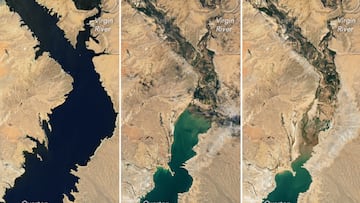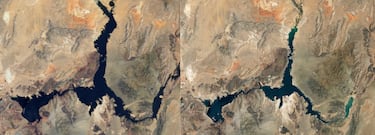NASA shows historic change in the largest reservoir in the US.
The Hoover Dam, on Lake Mead, has lost 24 meters of height in its water levels in 22 years, according to the Bureau of Reclamation (USBR).

NASA’s Landsa7 and Landsat 8 observation satellites have captured images showing changing water levels in Lake Mead, the largest artificial lake and reservoir in the United States. The data published by NASA itself is overwhelming: Lake Mead has only been 27% full this month of July.
Lake Mead drying up
If we compare the images from this summer with those captured by the same observation system 22 years ago, on July 6, 2000, we see how the water level has dropped in most of the area. According to NASA, it is a “clear illustration” of the effects of climate change and of a long-term drought “that may be the worst in the western US in 12 centuries.”

Lake Mead supplies water to millions of people in seven US states, tribal lands, and northern Mexico. Data from the US space agency explains that 74 percent of the nine western states face some level of drought. For example, 83% of the state of Colorado is currently in drought.
But how much has the water level dropped in Lake Mead?
According to data from the Bureau of Reclamation (USBR), the body that manages the country’s water in the west, the height of the water in the Hoover Dam was 341 meters in July 2000. Now it is 317 meters.
Where does the Lake Mead water come from?
Related stories
About 10% of Lake Mead's water comes from annual precipitation and groundwater. The rest comes from the melting of the Rocky Mountains. But not only the Mead is suffering the effects of climate change.
Also Lake Powell, which, according to NASA, is at 27% of its capacity. The entire Colorado River system is at 35 percent. As a measure, USBR has issued an emergency request to states in the Colorado River Basin to reduce water use by between two million and four million acre-feet over the next 18 months.

